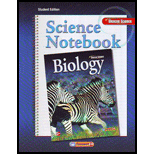
Concept explainers
To define:
The given terms using a book or a dictionary.
Introduction: Animals belonging to the phylum Echinodermata have unusual characteristics that distinguish them from animals of other phyla. These animals are found in all the oceans of the world. They move by means of hundreds of hydraulic, suction- cup- tipped appendages and have skin covered with tiny pincers.
Answer to Problem 3MI
Pedicellaria- These are small pincers on the skin of echinoderms that help in catching food and in removal of foreign materials from the skin.
Water vascular system- It is a system of fluid filled, closed tubes that work together to enable echinoderms to move and get food.
Madreporite- These are strainer like openings to the water vascular system in echinoderms.
Tube foot- These are small, muscular fluid filled tube that ends in suction- cuplike structure and is used for movement, food collection and respiration.
Ampulla- It is a muscular sac on a tube foot that contracts, forcing water into the tube foot.
Explanation of Solution
Echinoderms have a hard, spiny or bumpy endoskeleton covered by a thin epidermis. The long, pointed spines are very clearly seen in sea urchins. Sea stars also have spiny arms. Some spines found on sea stars and sea urchins are modified into pincer- like appendages called Pedicellariae. An echinoderm uses its pedicellariae for protection, catching food, and for cleaning the surface of its body.
Another feature of all echinoderms is their water vascular system- systems of fluid- filled closed tubes that work together enable echinoderms to move and get food. There is a strainer like opening to the water vascular system known as a madreporite. Water is drawn into the madreporite, then moves through the stone canal to the ring canal. From there water moves to the radial canals and finally to the tube feet.
Tube feet are small, muscular fluid filled tube that ends in suction- cuplike structure and is used for movement, food collection and respiration. The opposite end of the tube feet is a muscular sac called the ampulla. When the muscles contract in the ampulla, water is forced out into the tube feet and it extends. The suction cup- like structure on the end of the tube feet attaches it to the surface. This hydraulic suction enables all echinoderms to move.
Additional Science Textbook Solutions
Microbiology: An Introduction
Human Biology: Concepts and Current Issues (8th Edition)
Biological Science (6th Edition)
Brock Biology of Microorganisms (14th Edition)
Human Anatomy & Physiology (2nd Edition)
Genetic Analysis: An Integrated Approach (3rd Edition)
 Human Anatomy & Physiology (11th Edition)BiologyISBN:9780134580999Author:Elaine N. Marieb, Katja N. HoehnPublisher:PEARSON
Human Anatomy & Physiology (11th Edition)BiologyISBN:9780134580999Author:Elaine N. Marieb, Katja N. HoehnPublisher:PEARSON Biology 2eBiologyISBN:9781947172517Author:Matthew Douglas, Jung Choi, Mary Ann ClarkPublisher:OpenStax
Biology 2eBiologyISBN:9781947172517Author:Matthew Douglas, Jung Choi, Mary Ann ClarkPublisher:OpenStax Anatomy & PhysiologyBiologyISBN:9781259398629Author:McKinley, Michael P., O'loughlin, Valerie Dean, Bidle, Theresa StouterPublisher:Mcgraw Hill Education,
Anatomy & PhysiologyBiologyISBN:9781259398629Author:McKinley, Michael P., O'loughlin, Valerie Dean, Bidle, Theresa StouterPublisher:Mcgraw Hill Education, Molecular Biology of the Cell (Sixth Edition)BiologyISBN:9780815344322Author:Bruce Alberts, Alexander D. Johnson, Julian Lewis, David Morgan, Martin Raff, Keith Roberts, Peter WalterPublisher:W. W. Norton & Company
Molecular Biology of the Cell (Sixth Edition)BiologyISBN:9780815344322Author:Bruce Alberts, Alexander D. Johnson, Julian Lewis, David Morgan, Martin Raff, Keith Roberts, Peter WalterPublisher:W. W. Norton & Company Laboratory Manual For Human Anatomy & PhysiologyBiologyISBN:9781260159363Author:Martin, Terry R., Prentice-craver, CynthiaPublisher:McGraw-Hill Publishing Co.
Laboratory Manual For Human Anatomy & PhysiologyBiologyISBN:9781260159363Author:Martin, Terry R., Prentice-craver, CynthiaPublisher:McGraw-Hill Publishing Co. Inquiry Into Life (16th Edition)BiologyISBN:9781260231700Author:Sylvia S. Mader, Michael WindelspechtPublisher:McGraw Hill Education
Inquiry Into Life (16th Edition)BiologyISBN:9781260231700Author:Sylvia S. Mader, Michael WindelspechtPublisher:McGraw Hill Education





